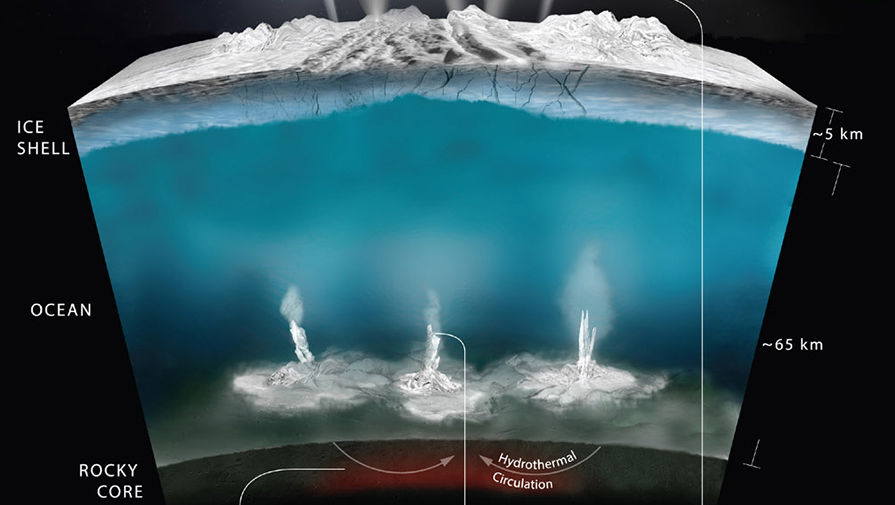Saturn - the reason for the existence of a liquid ocean on Enceladus

The fact that Enceladus , the satellite of Saturn, there is a liquid ocean, people learned thanks to the Cassini spacecraft. It was he who first photographed cryovolcanoes, and then flew through the zone of a volcanic plume, simultaneously analyzing the characteristics of particles emitted by the volcano. The existence of the ocean on the planetoid raises even more questions about Enceladus than before.
For example - as a relatively small object may exist under-ice ocean. Why is everything not frozen yet many tens of millions of years ago? An integrated team of astronomers tried to answer the question, recently published the results of their research in Nature Astronomy.
“The origin of the energy that allows Enceladus to heat its ocean has been a mystery for a long time. To find the answer to it, we analyzed the influence of the structure of the core of the planetoid and chemical composition on the energy generation process, using data obtained from Cassini, said Gaël Choblet from the University of Nantes (France).
According to the apparatus, the ocean has a rather large depth and is covered with a not-so-thick layer of ice that one would expect in such conditions. If there were no source of energy for heating water in the ocean, then Enceladus would be frozen for a long time. But, as we see, it is not so, which means that the energy is taken from somewhere, and in sufficient quantity for the existence of cryovolcanoes. Initially, experts have suggested that the source of heat on Enceladus are tidal forces. They, according to astronomers, stretch and squeeze the solid core of the planetoid. A little later, it turned out that this was clearly not enough to generate heat, allowing the ocean to exist for many millions of years.
The data collected by the Cassini probe during the last stage of its operation, shortly before the planned destruction of the vehicle, helped. Astronomers studied the dynamics of changes in the appearance of Enceladus as they move away from Saturn and approaching it. After analyzing all the available data, scientists have suggested that the core is not too dense. It contains a large number of voids, which occupy up to 30% of the volume of the nucleus. It is almost a stony "sponge". Water penetrates into the voids, which heats up, interacts with the rocks of the rocky core and then transfers heat to the water column.
Experts say that this model can explain why the geysers on Enceladus are located mostly on the south pole. The fact is that if the core really contributes to the heating of water, then the vast majority of these flows will accumulate at the poles. The more warm currents, the stronger the effect on the thickness of the ice. They gradually “eat up” it and lead to the appearance of rather massive cracks through which ocean water makes its way.
If you follow this idea, it becomes incomprehensible why cryovolcanoes are only at the south pole, and at the north they are almost nonexistent. Perhaps, astronomers say, the reason for the formation of Enceladus ice cover. At the North Pole, it can be thicker, and at the south, respectively - thinner. And the relatively small thickness of the layer allows water to break through the ice to the outside.
In the case of Enceladus, the "water cycle in nature" occurs every 25 million years. This means that an ocean of liquid water could exist on a planetoid even before it began to freeze. Some scientists believe that once on Enceladus there is water, that is, on the satellite of Saturn and the possibility of the existence of life. It could arise there in the course of a favorable set of circumstances. It is believed that the ocean of the planetoid is too saturated with mineral salts so that at least some life could exist there. Unfortunately, the truth will be revealed only in the future, when (and if) a person sends a probe to Enceladus to search for traces of life.
After 20 years of work for the benefit of earthly science, the Cassini probe was decided to be lowered into the depths of the atmosphere of Saturn, where the apparatus remained. But before shutting down, the probe managed to send to Earth information about the composition of the atmosphere of the planet-gas giant. This stage was named “ Grand Finale .” Scientists had a choice - either to launch Cassini into the atmosphere of Saturn, or to break it against the surface of Enceladus. It was decided to abandon the second option in order not to bring terrestrial microorganisms to the satellite of the gas giant.
All Articles